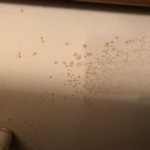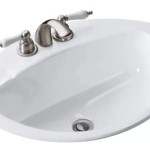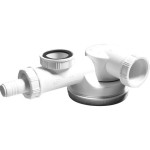Removing Mould From Bathroom Ceiling: A Comprehensive Guide
Mould growth in bathrooms, particularly on the ceiling, is a common problem due to the high humidity and lack of ventilation. Mould is not only unsightly but can also pose health risks, especially for individuals with allergies or respiratory conditions. This article provides a comprehensive guide to understanding mould formation, identifying different types, and effectively removing it from your bathroom ceiling, preventing its recurrence.
The presence of mould indicates an underlying moisture issue that needs to be addressed concurrently with the cleaning process. Simply removing the visible mould without resolving the source of the moisture will lead to its inevitable return. Therefore, a thorough investigation and remediation of the moisture source are crucial for long-term success.
Before commencing any mould removal process, it's essential to understand the potential health risks associated with mould exposure. Mould spores can trigger allergic reactions, asthma attacks, and other respiratory problems. Individuals with compromised immune systems are particularly vulnerable. Appropriate protective measures, such as wearing gloves, a mask, and eye protection, are mandatory to minimize exposure during the cleaning process.
Identifying Mould Types and Assessing the Severity of the Infestation
Mould comes in various types, each with its distinct appearance and potential health risks. Common types found in bathrooms include black mould (Stachybotrys chartarum), which is often associated with serious health problems, and other types, such as Alternaria, Aspergillus, and Cladosporium. While black mould raises the most concern, any mould growth should be addressed promptly.
The severity of the infestation plays a significant role in determining the appropriate removal method. Minor mould growth, covering a small area, can usually be handled with DIY cleaning solutions. However, extensive mould infestations, covering a large area or penetrating deep into the ceiling material, may require professional remediation services. A visual inspection is crucial to determine the extent of the mould growth. Check for hidden mould growth behind tiles or within the ceiling cavity.
Consider the underlying cause of the mould growth. Look for signs of water leaks around pipes, fixtures, or the roof. Addressing these leaks is essential before attempting to clean the mould. Ignoring the source of the moisture will only lead to the mould returning.
The composition of the bathroom ceiling also matters. Porous materials, such as drywall or ceiling tiles, are more susceptible to mould penetration than non-porous surfaces like painted plaster. This difference will influence the choice of cleaning solutions and techniques.
Effective Cleaning Solutions and Techniques for Mould Removal
Several effective cleaning solutions can be used to remove mould from bathroom ceilings. The choice of solution depends on the severity of the mould growth and the type of ceiling material. Always test the cleaning solution on a small, inconspicuous area first to ensure it does not damage or discolor the surface.
One common and readily available solution is a mixture of bleach and water. A ratio of 1 part bleach to 10 parts water is generally recommended. Apply the solution to the mouldy area using a sponge, cloth, or spray bottle. Allow the solution to sit for several minutes to penetrate the mould. Then, scrub the area gently with a brush or sponge to remove the mould. Rinse the area thoroughly with clean water and dry it completely.
Another effective option is white vinegar. Vinegar is a natural disinfectant and mould killer. Spray undiluted white vinegar onto the mouldy area and let it sit for an hour. Then, wipe the area clean with a damp cloth and allow it to air dry. Vinegar is less harsh than bleach and may be preferred for painted surfaces or areas where bleach fumes are a concern.
Baking soda is also a natural and safe alternative for mould removal. Mix baking soda with water to form a paste. Apply the paste to the mouldy area and let it dry. Then, scrub the area with a brush or sponge and rinse with water. Baking soda is effective in absorbing moisture and odors, helping to prevent future mould growth.
For more stubborn mould stains, consider using a commercial mould remover specifically designed for bathroom surfaces. Follow the manufacturer's instructions carefully and always wear appropriate protective gear. These products often contain stronger chemicals and may require more thorough ventilation.
When cleaning the ceiling, it's important to work safely and effectively. Use a sturdy ladder to reach the ceiling and avoid overreaching. Work in small sections and rinse the area thoroughly after cleaning. Ensure the bathroom is well-ventilated during and after the cleaning process to help dry the ceiling and prevent mould from returning. A fan can assist in the drying process.
Preventing Future Mould Growth: Ventilation and Moisture Control
Preventing mould growth is crucial for maintaining a healthy and mould-free bathroom. The most effective strategy is to control moisture levels and improve ventilation. Without addressing the underlying moisture issue, any cleaning efforts will only provide temporary relief.
Proper ventilation is essential for removing excess moisture from the bathroom. Ensure the bathroom exhaust fan is functioning correctly and use it every time you shower or bathe. The exhaust fan should be appropriately sized for the size of the bathroom. If the bathroom does not have an exhaust fan, consider installing one. Open a window, if available, to further enhance ventilation.
Address any water leaks promptly. Repair leaky faucets, showerheads, or pipes. Check for leaks around the toilet and under the sink. Even small leaks can contribute to moisture buildup and create a favorable environment for mould growth. Regularly inspect grout and sealant around tiles and fixtures and repair any cracks or gaps.
Control humidity levels in the bathroom. Consider using a dehumidifier to reduce moisture in the air, especially during humid months. Wipe down wet surfaces after showering or bathing to remove excess water. Leave the shower door or curtain open to allow air to circulate and dry the shower area thoroughly.
Regular cleaning can help prevent mould growth. Clean the bathroom regularly, paying particular attention to areas prone to moisture buildup, such as the shower, tub, and sink. Use a mould-resistant bathroom cleaner to help inhibit mould growth. Inspect the ceiling regularly for signs of mould growth and address any issues promptly.
Consider using mould-resistant paint on the bathroom ceiling. These paints contain additives that inhibit the growth of mould and mildew. Applying a fresh coat of paint can help protect the ceiling from moisture and prevent mould from taking hold. Ensure the surface is properly prepared before painting by cleaning it thoroughly and allowing it to dry completely.
By implementing these preventative measures, individuals can significantly reduce the risk of mould growth in their bathrooms and maintain a healthier indoor environment. Consistent attention to ventilation, moisture control, and regular cleaning is key to long-term mould prevention.

Bathroom Ceiling Mold Removal When To Clean Call Branch Environmental

Cleaning Mold From Bathroom Ceilings Like A Pro Lovetoknow

How To Remove Black Mold From A Bathroom Ceiling

Cleaning Mrs Hinch Fans Share Tips To Remove Ceiling Mould Express Co

Don T Let Mould Take Over How To Remove It From Your Ceiling

What Is The Best Way To Remove Mold From Bathroom Ceiling

How To Remove Mould From Your Bathroom Ceiling Cleanipedia Za

Mold On Bathroom Ceiling How To Clean Off

Mold On Bathroom Ceiling How To Clean Off

Black Spots On The Bathroom Ceiling Flood Water Damage Honolulu Oahu Hawaii Md Restoration
Related Posts







